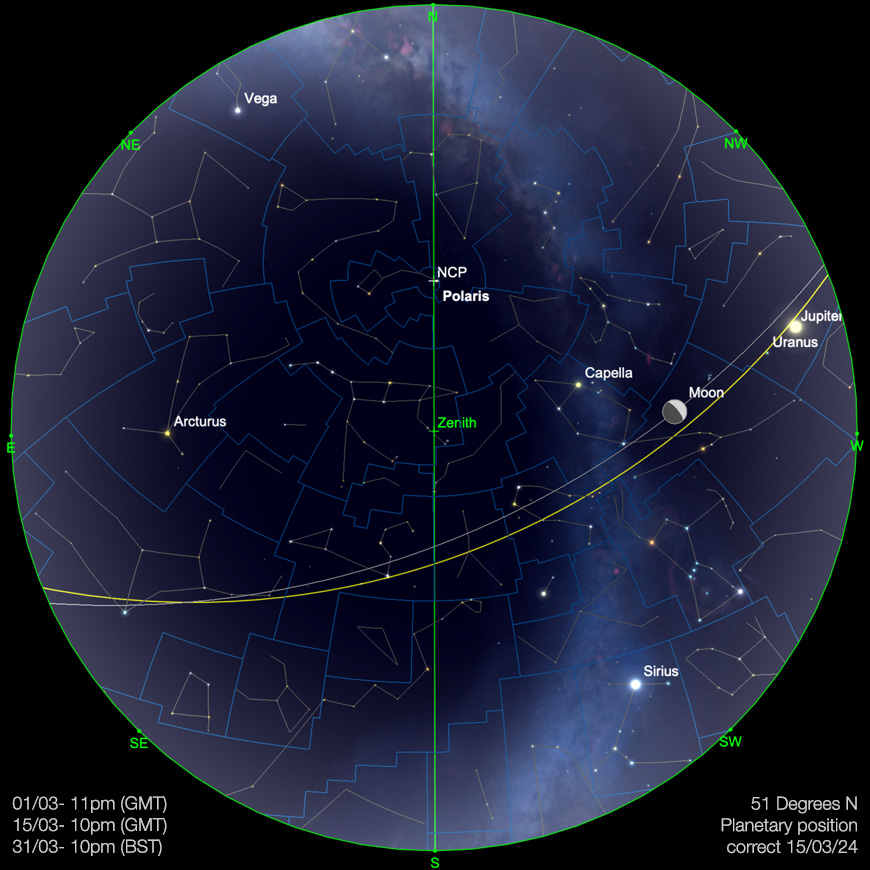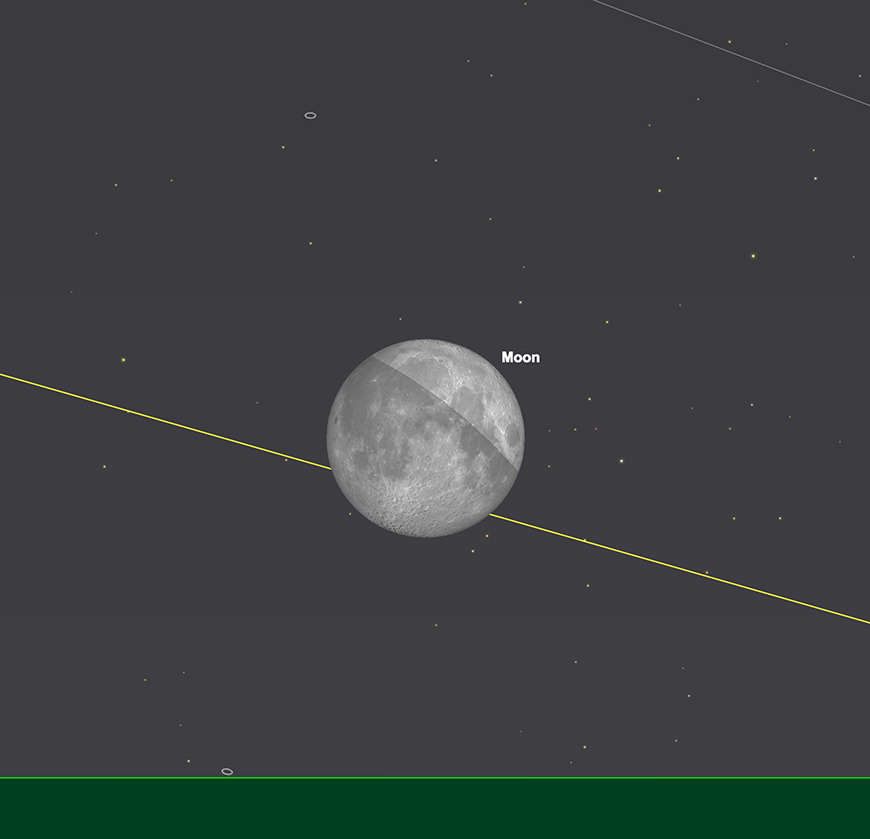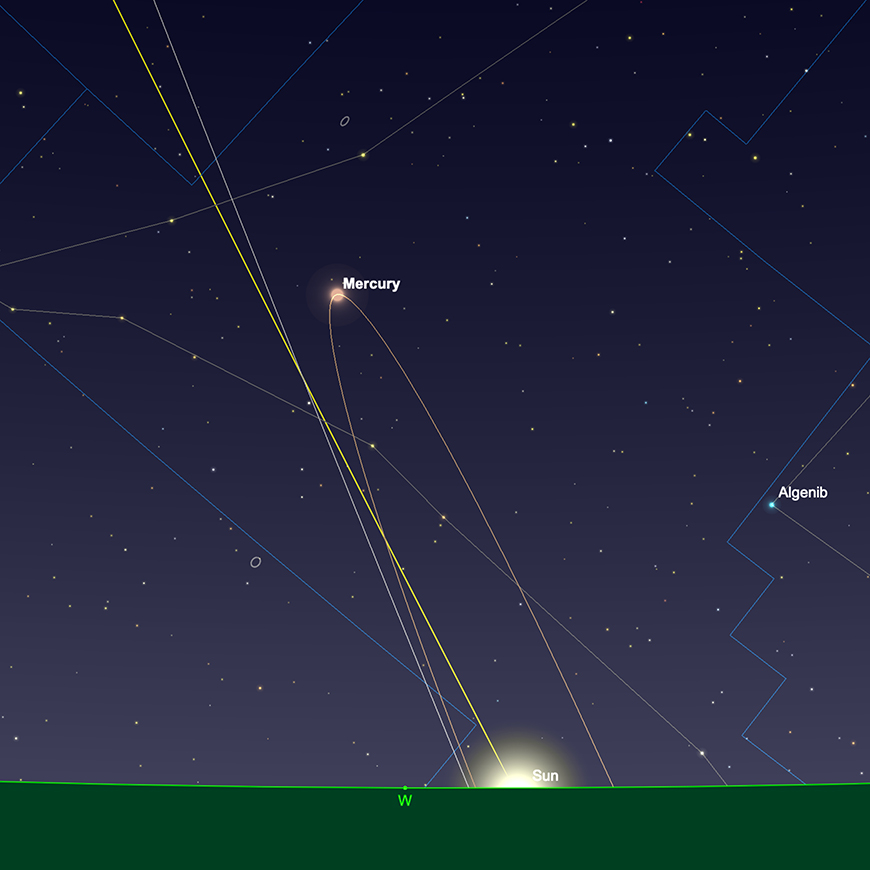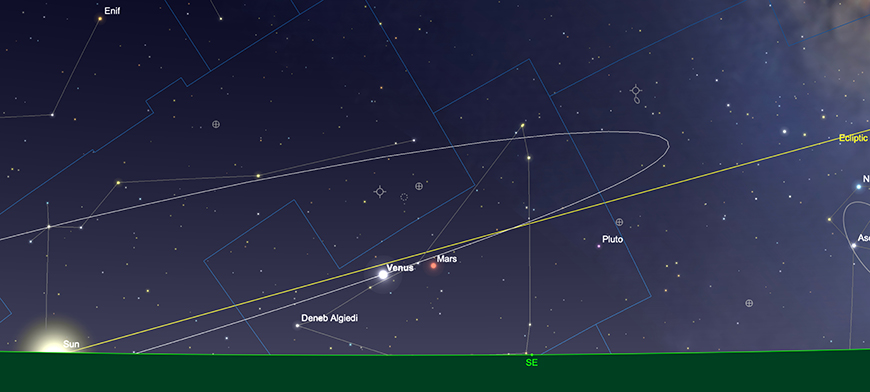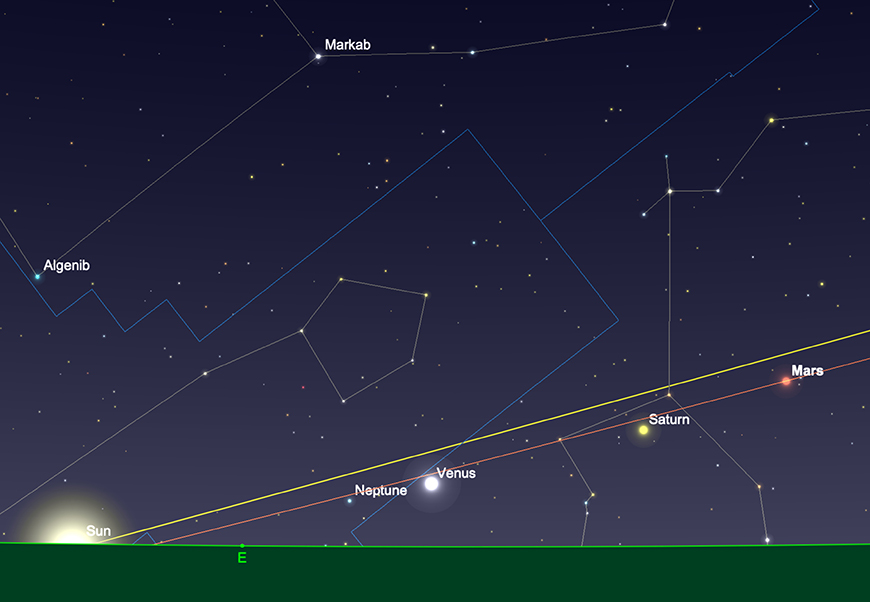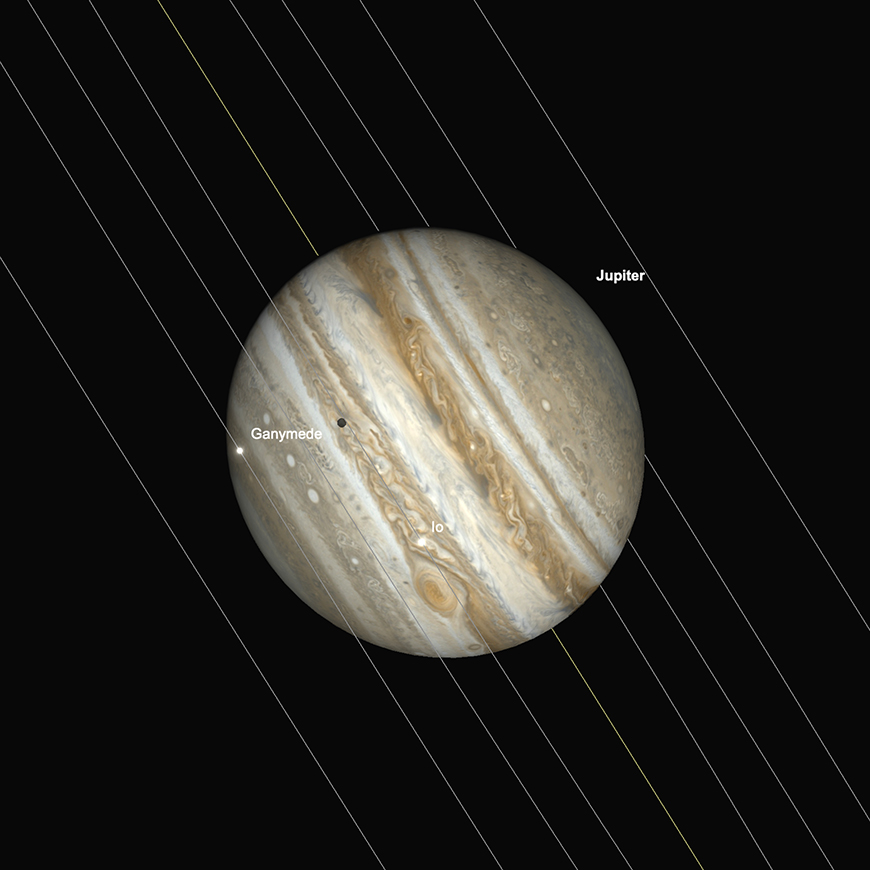Telescope House March Sky Guide
March is a transitional month as far as the sky is concerned, with the Sun transitioning from the southern celestial hemisphere to the northern. This is the annual Spring Equinox, which this year takes place on Wednesday 20th Mar 2024. This is the official start of Spring, though the way the seasons gradually unfurl is a complex affair, with many interlinked (and occasionally contradictory) signifiers. However, from and astronomical perspective, beyond this boundary is where those in the mid-northern hemisphere start to experience more daylight hours than hours of night. Likewise, house in the southern hemisphere experience exactly the opposite with the beginning of Autumn.
Those of us in mid-northern latitudes commonly outside at the crepuscular times of the day will definitely have noticed the encroachment of daylight in the mornings and evenings recently. The clocks will move forward on the 31st March for much of Europe, which will lead to lighter evenings for many. Moves were afoot in the European Union to abandon the practice of changing time twice a year, with legislation passed in 2019 to cease the practice. However these plans seem to have been paused for the time being. The USA and Canada will change clocks a little earlier this year, on the 10th March. Australia and New Zealand will wait until early April to perform their Autumnal reset. Not all countries practice time changes. Those closer to the equator experience much smaller seasonal variations in lengths of day and night, so the practice is rarely considered necessary.
The Solar System
The Sun
The solar system’s centrepiece continues to increase its activity. Cycle 25 - our current one - is not expected to reach its peak until 2025. Though it is difficult to definitively determine true solar maximum until it has passed. It will be interesting to monitor activity independently and draw our own conclusions. This is an area of scientific inquiry where the amateur, despite very sophisticated modern automated solar surveys, can still contribute. The BAA still accepts sunspot observations and has been receiving them from some individual observers continuously since the 1930s. Although those with more sophisticated H-alpha telescopes will have the best view of the solar surface, very reasonable observations can be made with inexpensive solar film, with any telescope (or even powerful binoculars).
Further and more detailed observations of the Sun can be found by referring to Michel Deconinck’s monthly newsletter here: https://astro.aquarellia.com/doc/Aquarellia-Observatory-forecasts.pdf - this newsletter also covers other observations made from Europe.
The Moon
We begin March with the Moon a resident of Libra. Rising at a little before midnight on the 1st, the Moon will be illuminated by just under 75%. Our natural satellite is waning during early March and will steadily decrease its phase as it moves through the most southerly regions of the ecliptic plane, taking in Scorpius, Ophiuchus, Sagittarius and up through Capricornus, where it will join Mars and Venus on the morning of the 8th.
The Moon will become new when it joins the Sun in Aquarius on the 10th, slipping to the south of the solar disk and then re-emerging as an evening object.
This month’s evening lunar apparition will result in one of the aforementioned “High Spring Evening Crescent Phases” for observers in the temperate northern hemisphere. This occurs at this time of year when the Moon ascends through a very steeply angled ecliptic plane, during the evenings. This maximises the Moon’s separation from the horizon and gives us some excellent observing possibilities, while at thin crescent phase.
The Moon will stand around 15 degrees high in the west at sunset on the evening of the 11th (as observed from 51 degrees North). Although only illuminated by 2.7%, the Moon should be visible and can act as a handy guide to Mercury, sitting at about half the height, in the same area of sky.
Two days later the 15% illuminated Moon will sit alongside Jupiter in the early evening sky - the two sharing the constellation of Aries. The Moon is gaining double digits on a daily basis in terms of degrees, when it comes to separation from the horizon at this point in time and will stand over 40 degrees as the sun sets.
The Moon continues to ascend through Taurus and crosses the border into southern Auriga, where it will come to first quarter phase on the evening of the 17th. By this point the Moon will reach nearly 67 degrees elevation from the horizon as the Sun sets (again, as observed from 51 degrees North). This is the highest first quarter Moon of the year - April’s will only reach 64 degrees elevation at sunset by comparison (as observed from the same latitude).
After reaching the dizzy heights of the most northerly part of the ecliptic, the Moon continues its track through Gemini, Cancer and Leo and then on into the expansive Virgo, where it will reach full on the evening of the 25th. This Full Moon is a special one as it also gives rise to a partial lunar eclipse, which will begin Penumbral stage at just before 5 am. The Moon will set from much of Europe before maximum eclipse has been reached, but those further west in the Americas will see much more of the event. This will definitely be one for the early risers amongst us, but even though it won’t reach completely Umbral phase of deepest eclipse, should still be interesting to witness.
Post eclipse, the Moon continues its journey through Virgo, and on into Libra and Scorpius. It ends the month at a waning, gibbous phase, illuminated by just over 70%, and occupying the non-zodiacal constellation of Ophiuchus
We begin March with the Moon a resident of Libra. Rising at a little before midnight on the 1st, the Moon will be illuminated by just under 75%. Our natural satellite is waning during early March and will steadily decrease its phase as it moves through the most southerly regions of the ecliptic plane, taking in Scorpius, Ophiuchus, Sagittarius and up through Capricornus, where it will join Mars and Venus on the morning of the 8th.
The Moon will become new when it joins the Sun in Aquarius on the 10th, slipping to the south of the solar disk and then re-emerging as an evening object.
This month’s evening lunar apparition will result in one of the aforementioned “High Spring Evening Crescent Phases” for observers in the temperate northern hemisphere. This occurs at this time of year when the Moon ascends through a very steeply angled ecliptic plane, during the evenings. This maximises the Moon’s separation from the horizon and gives us some excellent observing possibilities, while at thin crescent phase.
The Moon will stand around 15 degrees high in the west at sunset on the evening of the 11th (as observed from 51 degrees North). Although only illuminated by 2.7%, the Moon should be visible and can act as a handy guide to Mercury, sitting at about half the height, in the same area of sky.
Two days later the 15% illuminated Moon will sit alongside Jupiter in the early evening sky - the two sharing the constellation of Aries. The Moon is gaining double digits on a daily basis in terms of degrees, when it comes to separation from the horizon at this point in time and will stand over 40 degrees as the sun sets.
The Moon continues to ascend through Taurus and crosses the border into southern Auriga, where it will come to first quarter phase on the evening of the 17th. By this point the Moon will reach nearly 67 degrees elevation from the horizon as the Sun sets (again, as observed from 51 degrees North). This is the highest first quarter Moon of the year - April’s will only reach 64 degrees elevation at sunset by comparison (as observed from the same latitude).
After reaching the dizzy heights of the most northerly part of the ecliptic, the Moon continues its track through Gemini, Cancer and Leo and then on into the expansive Virgo, where it will reach full on the evening of the 25th. This Full Moon is a special one as it also gives rise to a partial lunar eclipse, which will begin Penumbral stage at just before 5 am. The Moon will set from much of Europe before maximum eclipse has been reached, but those further west in the Americas will see much more of the event. This will definitely be one for the early risers amongst us, but even though it won’t reach completely Umbral phase of deepest eclipse, should still be interesting to witness.
Post eclipse, the Moon continues its journey through Virgo, and on into Libra and Scorpius. It ends the month at a waning, gibbous phase, illuminated by just over 70%, and occupying the non-zodiacal constellation of Ophiuchus
Mercury
The solar system’s innermost planet starts March, emerging from superior conjunction, the opposing side of the Sun as seen from Earth. As such, Mercury will be invisible for the first part of the month. However, as all things mercurial are by their very nature, nothing stays the same for very long. Mercury rapidly increases its separation from the Sun and in doing so delivers one of the most spectacular evening apparitions of the year. By the time we get to the beginning of the second week in March, Mercury will sit at around 6 1/2°, above the horizon as the Sun sets. It will shine at a visual magnitude of -1.4 and display a 5.3 arc second diameter disc, illuminated by just under 95%. If you have a reasonable westerly horizon, it will be remiss not to attempt an identification of Mercury at this stage. However, as the days progress, Mercury continues to separate itself from the Sun, fading very slightly as it does. By the time we reach halfway through March, Mercury will stand at around 12 1/2° elevation at sunset (as viewed from 51° north) and will be shining at a steady -1.1 magnitude, its 5.9 arc second diameter disc illuminated by just over 78%.
Mercury reaches maximum eastern elongation on March 24th. At this point in time, Mercury will be standing around 16 and three-quarter degrees, above the horizon as the Sun sets (again, from 51° north), and although it will have diminished in magnitude to -0.1, the planet will have grown inside significantly to 7.5 arc seconds diameter and is now showing a distinct crescent phase, illuminated by just over 43%. As the area of sky that Mercury is in, namely, the constellation of Pisces, sets at quite an elevated angle, as seen from temperate northern latitudes at this time of year, this gives rise to significant separation from the horizon, making the elusive planet much easier to detect. Observers with both binoculars and telescopes are thoroughly encouraged to make the most of this, one of the best opportunities for observing Mercury this year.
The last few days of March sees Mercury start its journey back towards the Sun. This has the effect of rapidly diminishing its phase, whilst the planet’s size increases yet further. By the time we get to the end of March, Mercury will have diminished to a visual magnitude of +1.4 and now shows a 9.2 arc second diameter, eliminated by just under 18%. Mercury stands around 14 1/2° high in the west as the Sun sets.
Venus
Our neighbouring planet is sitting in the observing doldrums at present. The 1st sees Venus a morning target, shining brightly at -3.9 magnitude, showing an 11.1 arc second diameter disk, but sitting desperately low to the horizon as the sun rises. Elevated by just under 5 1/2°, as the Sun comes up, he will need a clear south, easterly horizon to see Venus at all. Once found, the planet is, as ever, extremely prominent. However, from observers in mid northern latitudes, its position in the sky is sub optimal as far as telescopic of observation is concerned.
Venus is heading back towards the Sun, as observed from our perspective here on earth, and it will still be sometime before it reaches superior conjunction in early June 2024, the conditions for observing for those of us in mid northern that attitude defines considerably as time progresses. By the end of March, Venus will be found some 17° to the west of the Sun and will attain an altitude of just under two and three-quarter degrees (as viewed from 51° north). Although Venus will still be shining at an extremely prominent -3.9 by this point in March, its position in the sky means that it will be missed by many. Those in the equatorial regions of the planet will still have a reasonable view of Venus at a significantly higher elevation at this point. However, for the rest of us, this particular Venusian apparition is drawing to a long and drawn out conclusion.
Mars
Mars is in a similar area of sky to Venus, the constellation of Capricorn - and as such is a morning target. The 1st of March sees Mars sitting a little to the west of Venus, separated by around three and three-quarter degrees. Where is Venus is bright, Mars is much less so, at +1.3 magnitude currently and displays a 4.2 arc second diameter disk. Unlike Venus, Mars is separating itself from the Sun at present. Early January sees the planets separated from the Sun by just over 28°, though once we hit mid March, this separation has increased to 31°. By this point, Mars will stand around 6 1/2°, above the horizon in the Southeast as the Sun comes up.
By the time we reach the end of the month, Mars will have brightened very fractionally to +1.2 magnitude and now displays an apparent size of 4.5 arc seconds. By this point in the month, Mars, now a resident of Aquarius, will stand just over 7° high in the south east at dawn.
Jupiter
The king of the planets stands at an altitude of 48° high in the sky (as viewed from 51° north), as the Sun goes down on March 1st. Shining at a brilliant -2.2, Jupiter will be a mistakable as the brightest object in the south-west after dark. Showing an apparent size 36.4 arc seconds diameter at the beginning of the month. Jupiter will be an excellent target for telescopic observation in the early evening. The planet will set at a little after 11:30 pm (GMT) on the evening of the 1st.
Jupiter is heading sunward as seen from our perspective here on Earth. By the time we reach mid March, the separation of Jupiter from the Sun has decreased from 59° at the month’s beginning, to 48°. At this point in time, the planet will stand around 40° high in the south-west at sundown. Jupiter will now display a visual magnitude of -2.1 having freed fractionally from the months beginning and decreased its size to just over 35 arc seconds diameter.
By the time we reach the end of March, Jupiter will have decreased its separation from the Sun to a little under 36° and while staying static at -2.1 magnitude has shrunk fractionally just over 34 seconds diameter. The planet will stand at just under 30° elevation in the west at sunset. It will set at a little past 11 pm (BST) on the evening of the 31st.
There are a few mutual transit events in March as far as Jupiter is concerned. There is a mutual transit of the Great Red Spot and Europa, which begins at around 7 pm (GMT) on March 3rd. There is an excellent early evening GRS, Io and Ganymede transit, which peaks at around 4pm on March 18th. This is followed by a GRS, Europa and Europa shadow transit, which peaks at similar time on March 21st. There is another excellent GRS, Io, Io shadow transit and Ganymede transit at around 7 pm, March 25th. There is another mutual GRS and Europa transit, which starts around 5 pm on March 28th.

 English
English

